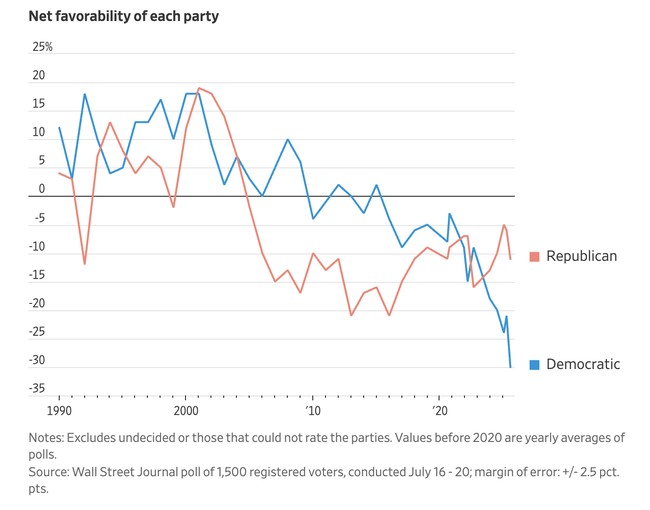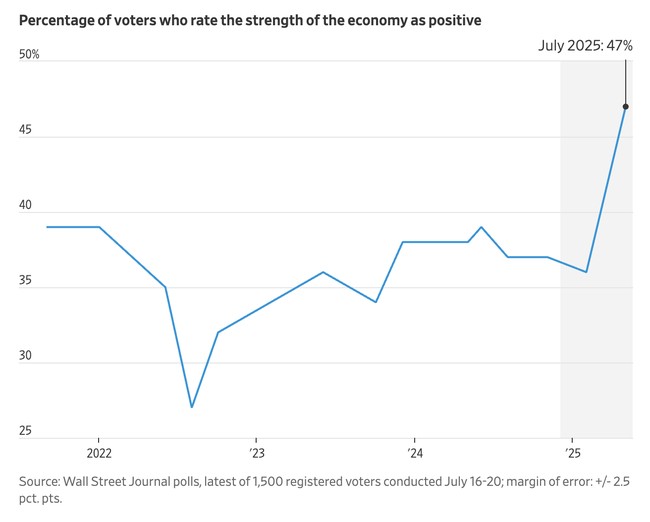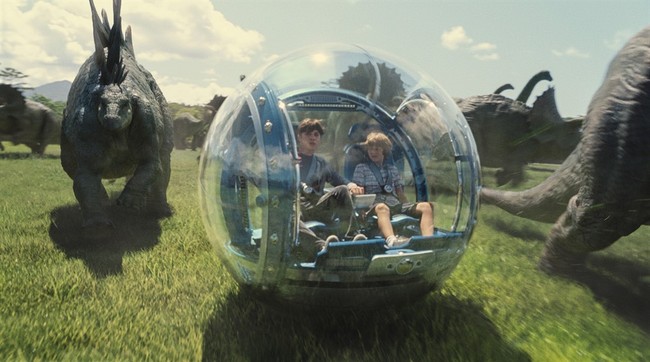The other day, I wrote about how confusing the polls regarding Donald Trump have been in recent months.
Yes, I know that pollsters juke the polls to some extent, and a lot of them have pretty crappy models of the electorate. I also know that different polls use samples of different groups–some use “adults,” others “registered voters,” and yet others focus on likely voters.
But still, the polls aren’t clustering–even roughly–around some number and diverging from there. There are actually two peaks in the polling data–one around a rating of -6 and another closer to -12 or more. That shouldn’t happen. In fact, in the 2024 election, it looks like non-voters may have been more pro-Trump than the electorate was, not less.
🧐
WSJ: Democrats Get Lowest Rating From Voters in 35 Years pic.twitter.com/Nhcxq5awbq
— Tom Bevan (@TomBevanRCP) July 26, 2025
If there is one thing that all the polls show, it is that Democrats are in deep trouble. Nobody likes them, including Democrats. I know lifelong Democrats who made regular, monthly donations–basically a tithe–who cut the party off because they are so angry.
The Democratic Party’s image has eroded to its lowest point in more than three decades, according to a new Wall Street Journal poll, with voters seeing Republicans as better at handling most issues that decide elections.
The new survey finds that 63% of voters hold an unfavorable view of the Democratic Party—the highest share in Journal polls dating to 1990 and 30 percentage points higher than the 33% who hold a favorable view.
That is a far weaker assessment than voters give to either President Trump or the Republican Party, who are viewed more unfavorably than favorably by 7 points and 11 points, respectively. A mere 8% of voters view the Democrats “very favorably,” compared with 19% who show that level of enthusiasm for the GOP.
Now it’s common for Congress and the parties to poll less well than particular individuals within them, but the erosion of popularity for the Democrats has the potential to be toxic. Elections are won on margins, and outside of national and statewide races, voters often vote for the party and not the person. As hard as it is to believe, large numbers of people have no idea who their Congresscritter is, and even in statewide races, decisions are often made on party ID alone, even by independents.
 If they are unhappy, they vote for the other party’s candidate to oust the incumbent. So party approval matters a lot.
If they are unhappy, they vote for the other party’s candidate to oust the incumbent. So party approval matters a lot.
Trump’s approval ratings, according to the Journal’s poll, are still strong–at least for Trump, who starts off with a much lower floor than most politicians.
Buoyed by voters’ improving views of the economy, President Trump’s political standing is showing notable resilience, a new Wall Street Journal poll finds, despite the unpopularity of the GOP’s big tax-and-spending law, dissatisfaction with Trump’s tariff plan and high suspicion that the government is hiding important information about its investigation into Jeffrey Epstein.
The set of turbulent recent events, which also has included the administration’s aggressive deportation program and the U.S. bombing of Iran’s nuclear sites, has failed either to dent or improve the public’s overall view of the president. Some 46% approve of his job performance—unchanged from April—with 52% disapproving.
The poll shows why the near-unshakeable backing of Trump’s Republican base is so valuable to him. With 88% of GOP voters approving of his job performance—and 66% strongly approving—he has been able to retain political potency in Congress and among much of the electorate when voters overall are dissatisfied with the country’s direction and disapprove of the president’s handling of the economy, inflation, tariffs and other aspects of his agenda.
Even though voters express disapproval for many of Trump’s policies, and the ratings are tepid even on his strongest issue, immigration, people have a deep well of trust (or, for some, distrust) in Trump. Their sense that the country is moving in the right direction is improving compared to the absolute sense of depression we have seen in recent years.
But voters are distinguishing between the direction of the country under Trump and the direction of the economy, on which the poll finds a brightening outlook.
Some 47% in the survey rated the economy as excellent or good—a significant, 11-point leap from April and the most positive rating in Journal surveys dating to 2021. Some 51% of voters assessed the economy as not good or poor, compared with 63% who said so in April.
By 8 points, more voters say the economy is getting worse rather than better—a sour outlook, but markedly improved from the 26-point gap in April. Fewer also said that inflation was causing them major financial strains.

At 46%, Trump’s job approval rating is stronger than the 40% he drew at this point in his first term, and it sits at the upper end of the unusually narrow range that marked voter views of his performance during his first White House term.
By contrast, views of Presidents Barack Obama and Joe Biden varied far more widely. Obama’s job-approval rating moved in a 20-point range, between 40% and 61%, and it stood at 45% at this point in his second term before he finished his time in office at 56%. Biden’s approval rating stood at 50% at this point in his term before sinking into the low 40s, NBC polling found.
“They called Reagan the Teflon president,” said Democratic pollster John Anzalone, who conducted the Journal survey with Republican Tony Fabrizio, referring to the adage that bad news rarely stuck to Republican President Ronald Reagan. “Trump has that in him, as well.” While Trump stirs up plenty of controversies that could be politically damaging, he said, “They seldom bite him on the backside.”
In short, Democrats are snakebit, and Trump has teflon-coated armor. People have made up their minds on Trump, and his numbers don’t move much at all; and unless the Democrats change strategies–and that looks increasingly unlikely–people’s view of the party could soon be set in amber. It will take scientists to drill into it, extract DNA, and recreate the party as a living being.
 As a practical matter, it takes an awful lot of damage to sink the battleships that are American political parties. The last major party to die in the US was the Whigs–the Republicans took their place–and it is hard to see a situation where the Democrats just die as a party.
As a practical matter, it takes an awful lot of damage to sink the battleships that are American political parties. The last major party to die in the US was the Whigs–the Republicans took their place–and it is hard to see a situation where the Democrats just die as a party.
But at the moment, their only hope for a revival in public image is an implosion in the Republican Party.
Juking leftward–the current path the Democrats seem to be going down–may help them in a few districts, but will do nothing to improve their image with ordinary Americans. AOC and Zohran Mamdani may bring in new voters, but they repel even more of them.
I still have no adequate explanation for the bimodal curve in the presidential approval polls, but a friend of mine who taught Political Science and American Politics for decades sent me an email after my last post on this. He said the explanation was simple: “The short answer is that a lot of polling is broken and most Internet polls are crap. The methods vary a lot now, as do the results.”
Seems about right.
Help us continue to report on the president’s economic successes and combat the lies of the Democrats. Join Hot Air VIP and use promo code FIGHT to get 60% off your membership.












